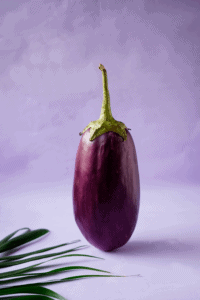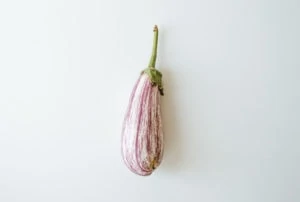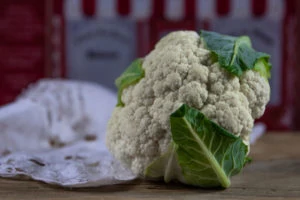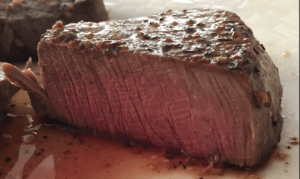Want to know how to cook eggplant? It’s easy to do with this simple recipe. Start by chopping the eggplants into cubes or eggplant slices, adding a little bit of olive oil and salt, and cooking them in the oven for 40 minutes at 400F.
There are dozens of ways to prepare this versatile vegetable. If you haven’t tried them before, you won’t believe how good they taste!
How to Pick a Good Eggplant for Roast Eggplant
There are different types of eggplants (Solanum melongena) – but you shouldn’t worry about that. More likely than not, you’ll encounter regular eggplants in the supermarket instead of the different variants such as Thai, Japanese, and the like. What will help you find the right eggplant for making roast eggplant is:
- Freshness: Fresh food first! Always try to go for fresh eggplants. It should be your first (and perhaps only) choice. Canned goods are always dipped in preservatives, and sometimes are pre-cooked, which is not good. You can’t inspect frozen or canned produce either.
- Size: You might think you have the perfect piece of eggplant – and even better, it’s so big that one will be enough for you! Well, let’s hold your horses. Small eggplants are better than larger ones. The bigger the eggplant, the more bitter it can get.
- Skin: No marks, no blemishes, and no spots. Your eggplant should look picture-perfect. Some vegetables can take a hit and maintain quality; unfortunately, eggplant is not one of those vegetables.
- Weight: Once you have spotted the perfect eggplant (fresh, small- or medium-sized, and spot-free), you should pick it up for a final test. It needs to feel heavy in your hand and full when you squeeze it.
Roasted Eggplant Recipe
Here’s what you’ll need to make the most delicious roasted eggplant.
Ingredients
- 1 Eggplant
- Olive oil
- Salt
Prepping the Eggplant
Now that you have the perfect, fresh eggplant, you can start the prep work necessary before making it into roast eggplant.
Step 1: Wash your eggplant
Give your eggplant a good rinse to get rid of the dirt and anything else that shouldn’t be on your eggplant. You’ll peel it in a second, but it’s always best to be safe. Dry it with paper towels.
Step 2: Peel and slice your eggplant
The very first thing you want to do is chop the stem off the eggplant with a knife. Throw the stem in the trash and get ready to peel.
You can either choose your trusty vegetable peeler or the knife you just used to peel your eggplant. I prefer to peel eggplant with a vegetable peeler simply out of convenience.
Step 3: Chop your eggplant
Using that same knife from earlier, chop the eggplant into little cubes or eggplant slices. Try to make them all nice and even – that way your roasted eggplant will come out of the oven evenly cooked.
Alternatively, in this recipe, you can cut the eggplant into eggplant slices.
Step 4: Salt cubes or eggplant slices
Grab a bowl, and put a colander inside. Place the eggplant cubes or eggplant slices inside the colander. Sprinkle salt on them. Let them rest for 20 to 30 minutes in order for the vegetable to absorb the salt for better flavoring.
Why do you need both a bowl and a colander? Because the eggplant will lose a little bit of its water content – and you don’t want to make a mess if there’s excess moisture! If you leave the eggplant in a bowl alone, it’ll be extra difficult to dry the cubed pieces or eggplant slices later on.
Step 5: Rinse and dry the eggplant cubes or slices
Grab the colander and place it underwater for 30 seconds. Once that’s done, grab a drip cloth and put the eggplant cubes or eggplant slices there. Dry them gently.
Step 6: Set the eggplant cubes or eggplant slices on a baking sheet
Grab a baking tray or sheet and then take the eggplant cubes or cut eggplant slices from the paper and put them on the sheet. Lay them out evenly and drizzle with olive oil.
Salt the eggplant generously here if you haven’t already. Baked eggplant that’s well-salted is yummiest for dipping in sauces.
Cook Eggplant in the Oven
Once you’ve completed the prep work, you’re ready to cook the eggplant in the oven. Oven-cooking eggplant results in a delicious roast eggplant that’s soft and golden-brown.
Step 1: Preheat the oven
Set the oven to 400F (205C ). Give it a moment to heat up. As you do, clear your cooking space!
Step 2: Cook the eggplant
Place the baking sheet in the oven. Roast eggplant for 20 minutes and then flip the cooking cubes. Baked eggplant for another 20 minutes. If the oven roasted eggplant is brownish and tender, the baked eggplant roast is ready to go!
There you have your oven roasted cubes or roast eggplant slices! Now you can eat a delicious dish and feel healthy about it too, and it was as simple as buying the eggplant, cutting and seasoning it, and baking it in the oven.
How to Properly Store Eggplant
More people buy carrots or salad than eggplants. Since oven roasted eggplant recipes aren’t as common, you may be wondering what is the correct way to store it after you buy it.
Storing Fresh Eggplant
It’s ideal to use eggplant as soon as you can after purchasing it, but if that’s not possible, you want to be careful about what temperature you store it at. Eggplant is sensitive to colder temperatures (such as around 40F and colder). These lower temperatures will damage the vegetable and make it go bad faster.
You can store eggplant in the fridge if your fridge is kept on the higher end of refrigeration temperatures. Otherwise, keep eggplants in a cool, dry place.
Also, be careful to keep eggplant separate from other fruits and vegetables high in ethylene (such as bananas and tomatoes) because this natural chemical causes the eggplant to ripen faster.
Storing Cooked Eggplant
Store baked eggplant the same as you would other cooked vegetables: place it in an airtight container and keep it in the fridge.
Are Eggplants Good for You?
Eggplants have nothing but net positives for you: they’re high in fiber, rich in nutrients, and low in calories. Because of their many benefits, eggplants are a staple in any healthy diet.
What Can You Do With Eggplant Skins?
While this recipe calls for peeling the eggplant, you can eat eggplant with the skin on. If you decide to cook the vegetable with the skin, buy young, smaller eggplants. They have skin that’s not so tough and more enjoyable to eat.
If you want something to do with the eggplant skin once the vegetable is peeled, you can fry them in oil and enjoy the crunchy snack with a squeeze of fresh lemon juice and shredded mozzarella. Or, after digging out the insides, you can stuff the eggplants with various ingredients as you do with bell peppers, and cook them in a marinara sauce.
Recipe Notes and Other Eggplant Recipes
There are plenty of delicious eggplant recipes that call for baking eggplant — sliced eggplant, eggplant roast, or cubed eggplant.
- Eggplant parmesan — One of my favorites, especially with homemade tomato sauce and fresh-shredded parmesan
- Grilled eggplant — Grilled eggplant recipes vary, but the main idea is to pop it on a grill to get the lines and the charr before baking it
- Yummy additions — Great parings with eggplant include mozzarella cheese, parmesan cheese, marinara sauce, spaghetti sauce, fresh basil, Balsamic vinegar, fresh garlic, bread crumbs, melted butter, kosher salt
- Leeks can make a fresh and delicious side to an eggplant main course














